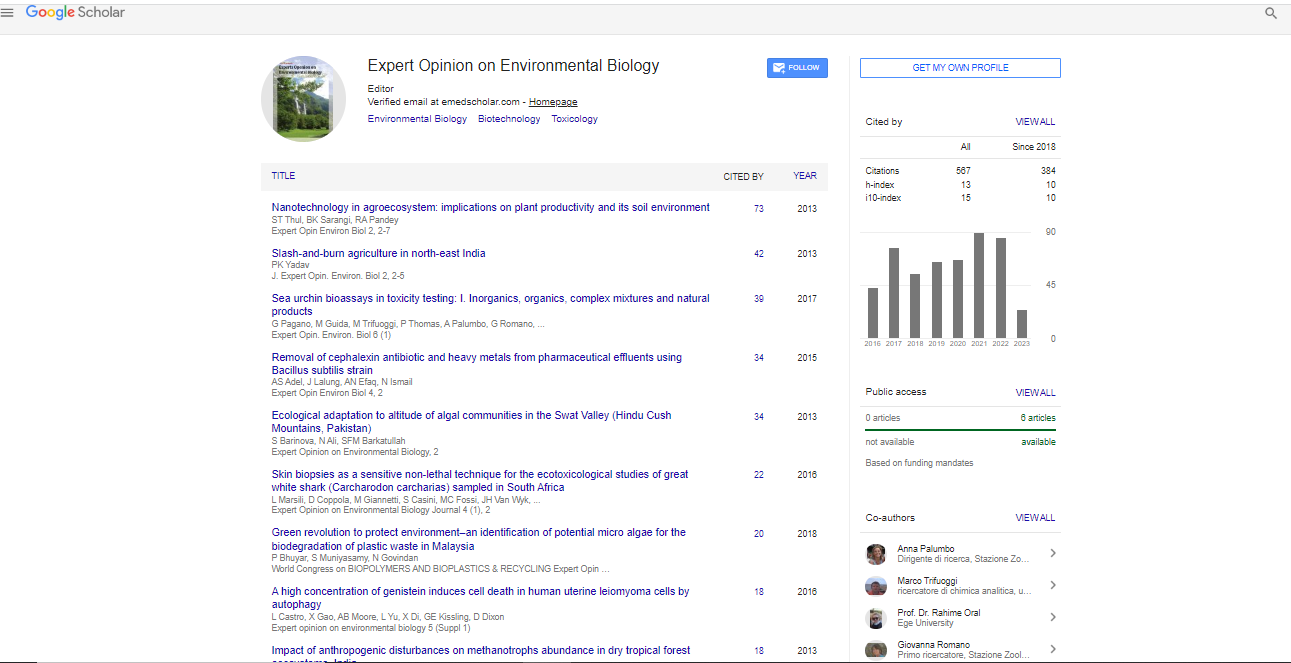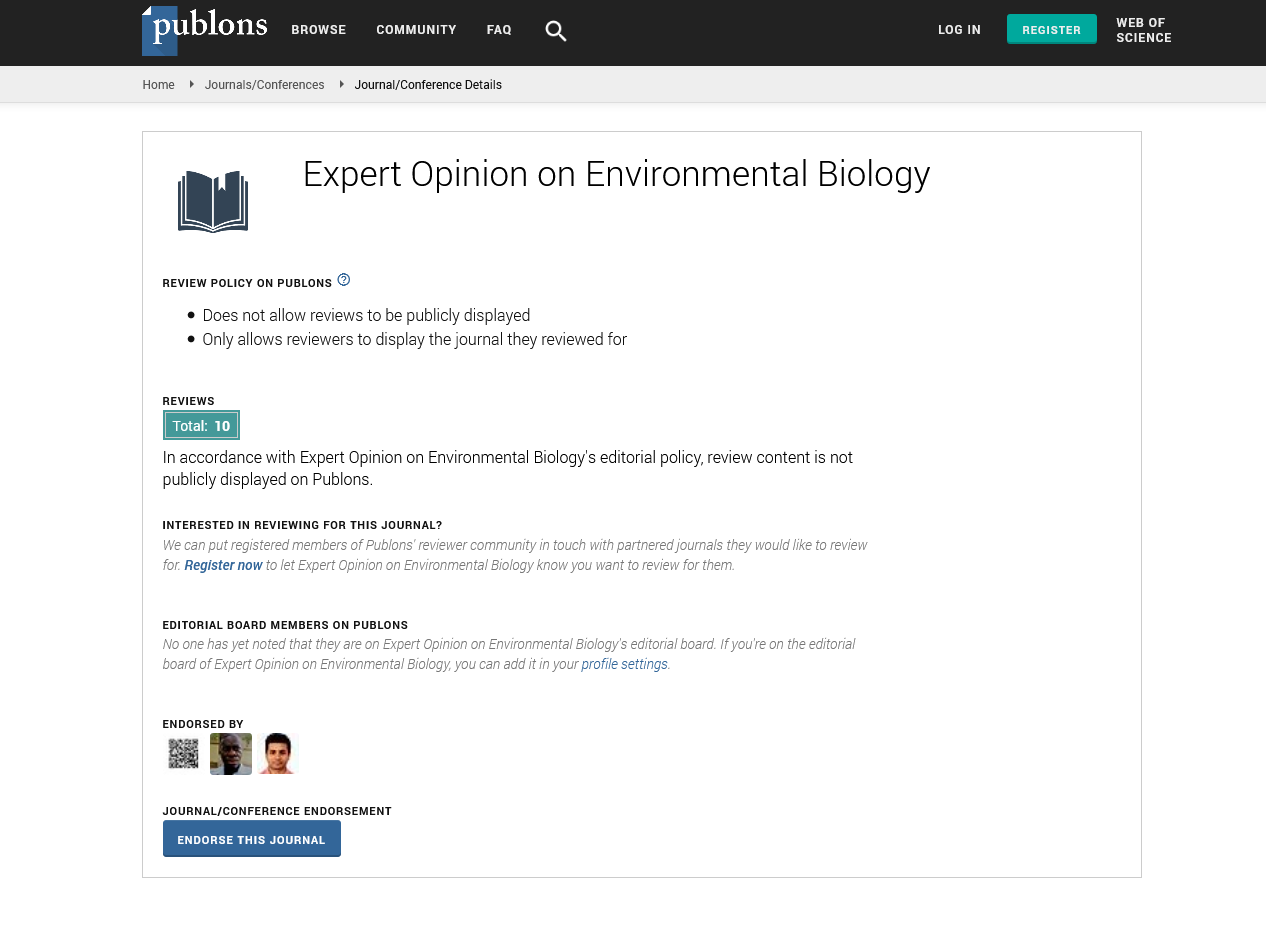Perspective, Expert Opin Environ Biol Vol: 14 Issue: 1
Microplastic Pollution: Ecological Impacts and Remediation Strategies
Fiun Lieng*
Department of Environmental Science and Engineering, Nankai University, China
- *Corresponding Author:
- Fiun Lieng
Department of Environmental Science and Engineering, Nankai University, China
E-mail: fiun_lieng@nu21.cn
Received: 01-Mar-2025, Manuscript No. EOEB-25-169982, Editor assigned: 03-Mar-2025, PreQC No. EOEB-25-169982(PQ), Reviewed: 17-Mar-2025, QC No. EOEB-25-169982, Revised: 21-Mar-2025, Manuscript No. EOEB-25-169982(R), Published: 28-Mar-2025, DOI: 10.4172/ 2325-9655.1000243
Citation: Fiun L (2025) Advancing Cardiac Healing: The Role of Stem Cells in Regeneration and Future Prospects. J Regen Med 14:1.
Copyright: © 2025 Fiun L. This is an open-access article distributed under the terms of the Creative Commons Attribution License, which permits unrestricted use, distribution and reproduction in any medium, provided the original author and source are credited.
Abstract
Microplastics, defined as plastic particles less than 5 mm in size,
have emerged as a significant environmental threat, permeating
terrestrial, freshwater, and marine ecosystems. Their persistence,
potential for bioaccumulation, and ability to transport toxic
chemicals pose risks to biodiversity and human health. This article
reviews the sources and pathways of microplastic pollution, its
ecological impacts across trophic levels, and the challenges in
monitoring and quantification. Furthermore, the paper evaluates
emerging remediation strategies, including physical removal
methods, bioremediation using plastic-degrading microbes, and
policy interventions aimed at reducing plastic production and
waste. Advancing research on detection techniques and scaling up
biodegradation technologies are crucial for mitigating the long-term
environmental consequences of microplastic pollution.
Keywords: Microplastics; pollution; Marine ecosystem; Biodegradation; Environmental remediation
Keywords
Microplastics; pollution; Marine ecosystem; Biodegradation; Environmental remediation
Introduction
Microplastic pollution has gained global attention in recent decades due to the exponential increase in plastic production and the subsequent fragmentation of plastics in the environment. Microplastics originate from primary sources, such as industrial abrasives and cosmetic products, and secondary sources, resulting from the degradation of larger plastic debris. Their ubiquity in soil, freshwater bodies, and oceans has raised concerns regarding their persistence, ecological disruption, and potential entry into the human food chain. Understanding the extent and effects of microplastics is essential to designing effective mitigation strategies [1].
Description
Microplastics are classified based on their origin:
- Primary microplastics â?? intentionally manufactured small particles for use in cosmetics, industrial cleaning, and synthetic textiles.
- Secondary microplastics â?? formed from the breakdown of larger plastic items through mechanical abrasion, photodegradation, or chemical weathering.
Once released, microplastics can be transported by wind, rivers, and ocean currents, leading to their global distribution. In marine environments, they are ingested by plankton, fish, and seabirds, leading to physical blockage of digestive tracts, reduced nutrient absorption, and altered feeding behavior. Moreover, microplastics act as vectors for persistent organic pollutants (POPs) and heavy metals, which adsorb onto their surfaces and biomagnify through food webs [2].
Ecological impacts
- Marine ecosystems: Microplastics threaten biodiversity by causing injury and mortality in marine species through ingestion and entanglement.
- Freshwater systems: Lakes and rivers serve as conduits for microplastics, impacting freshwater fish and benthic invertebrates.
- Terrestrial habitats: Soil microplastics can alter soil structure, affecting microbial communities and nutrient cycling [3].
Remediation strategies
- Physical removal: Filtration systems for wastewater treatment plants can significantly reduce microplastic outflow.
- Bioremediation: Certain bacterial strains, such as Ideonella sakaiensis, can degrade polyethylene terephthalate (PET), offering a sustainable approach.
- Policy and awareness: Banning microbeads in cosmetics, improving waste management, and promoting biodegradable plastics are crucial policy measures [4].
Results
Studies indicate microplastic concentrations in marine surface waters ranging from 0.1 to 10,000 particles per cubic meter. Removal efficiency in advanced wastewater treatment plants exceeds 95%, yet substantial quantities still enter natural ecosystems due to incomplete global infrastructure coverage. Biodegradation research shows promising laboratory results, but large-scale implementation remains in its infancy.
Discussion
While remediation technologies are progressing, prevention through reduced plastic use and improved waste management is the most effective solution. Public education, corporate responsibility, and international cooperation are critical for long-term success. Detection methods such as Raman spectroscopy and pyrolysis-GC-MS are enhancing our understanding of microplastic pollution dynamics, but standardization is needed for reliable comparisons across studies [5].
Conclusion
Microplastic pollution is a pervasive and persistent problem requiring coordinated global action. Combining prevention, technological innovation, and policy enforcement can substantially mitigate its ecological and human health risks. Future research should focus on scalable bioremediation techniques and comprehensive monitoring systems to track progress in combating microplastic pollution.
References
- Silink M (2008) Turning points in the fight against diabetes. Diabetes Voice 52: 2.
- Thomas MC, Walker MK, Emberson JR, Thomson AG, Lawlor DA, et al. (2005) Prevalence of undiagnosed Type 2 diabetes and impaired fasting glucose in older British men and women.. Diabet Med 22: 789â??793.
- Fiske J (2004) Diabetes mellitus and oral care. Dent Update 31: 190â??198.
- Scully C, Epstein J, Wiesenfeld D (2005) The Oxford handbook of dental patient care. Oxford: Oxford University Press.
- Basu A, Close CF, Jenkins D, Krentz AJ, Nattrass M, et al. (1993) Persisting mortality in diabetic ketoacidosis. Diabet Med 10: 282â??284.
 Spanish
Spanish  Chinese
Chinese  Russian
Russian  German
German  French
French  Japanese
Japanese  Portuguese
Portuguese  Hindi
Hindi 
